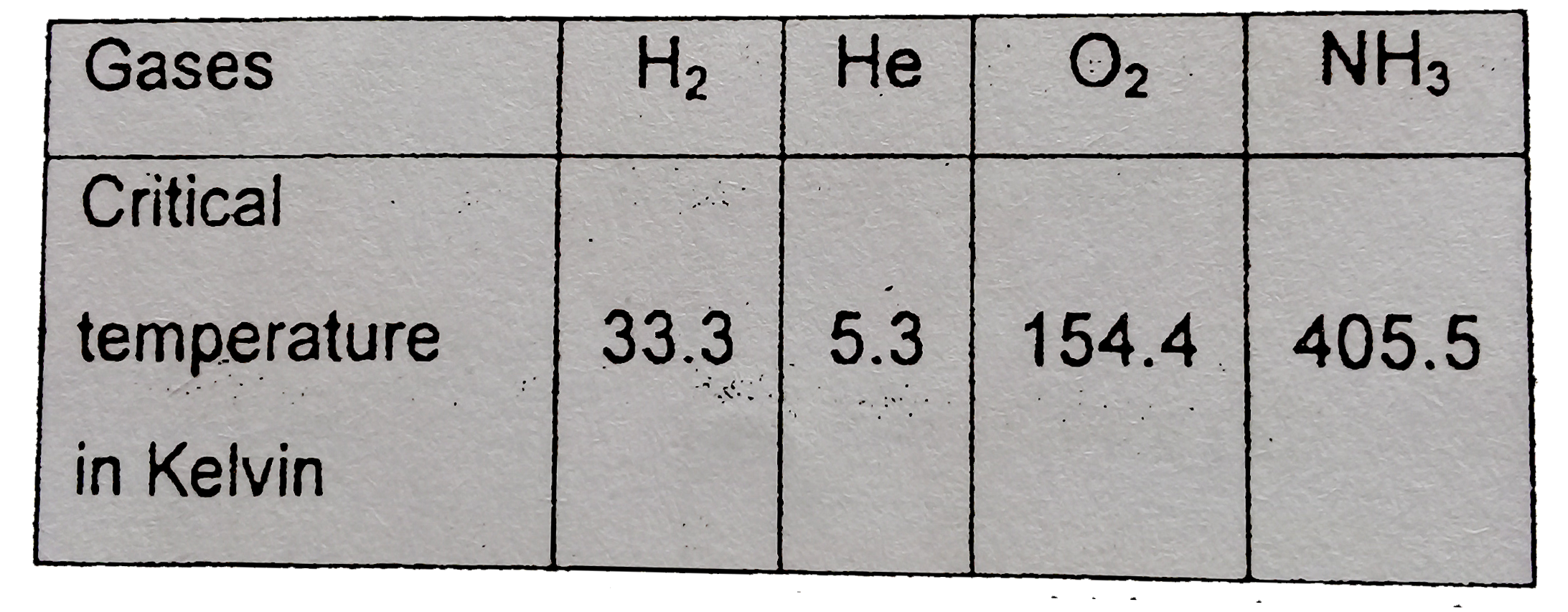Gases possess characteristic critical temperature which depends upon the magnitude of intermolecular forces between the gas particles. Critical temperatures of ammonia and carbon dioxide are 405.5 K and 304.10 K respectively. Which of these gases will liquify first when you start cooling from 500 K to their critical temperature ?
We have read that a gas gets liquefied when cooled below its critical temperature (Tc) . Upon cooling from 500 K, the critical temperature of ammonia (405.5K) will be attained first. It will get liquefied first as compared to carbon dioxide for which critical temperature (304.15K) is attained on further cooling.
Topper's Solved these Questions
- BOOK - DINESH PUBLICATIONCHAPTER - STATES OF MATTER : GASES AND LIQUIDSEXERCISE - Exercise Fully Solved23videos
STATES OF MATTER : GASES AND LIQUIDS
- BOOK - DINESH PUBLICATIONCHAPTER - STATES OF MATTER : GASES AND LIQUIDSEXERCISE - Short Answer Type Questions45videos
STATES OF MATTER : GASES AND LIQUIDS
- BOOK - DINESH PUBLICATIONCHAPTER - STATES OF MATTER (SOLID STATE CHEMISTRY)EXERCISE - ULTIMATE PREPARATORY PACKAGE21videos
STATES OF MATTER (SOLID STATE CHEMISTRY)
- BOOK - DINESH PUBLICATIONCHAPTER - STRUCTURE OF ATOMEXERCISE - Reason Type Questions1videos
STRUCTURE OF ATOM
Similar Questions
Gases possess characteristic critical temperature which depends upon the magnitude of intermolecular forces between the gas particles. Critical temperatures of ammonia and carbon dioxide are 405.5 K and 304.10 K respectively. Which of these gases will liquify first when you start cooling from 500 K to their critical temperature ?
View SolutionGases possess characteristic critical temperature which depends upon the magnitude of intermolecualr forces between the gas particles, critical temperatures of ammonia and carbon dioxide are 405.5 K and 304.10 K respectively. Which of these gases will liquefy first when you start cooling from 500 K to their critical temperature ?
View Solution
Knowledge Check
- Question 1 - Select One

Gases possess characteristic critical temperature which depends upon the magnitude of intermolecular forces between the particles. Following are the critical tempeatures of some gases. From the above data what would be the order of liquefaction of these gases? Start writing the order from the gas liquefying first.AHe,H2,O2,NH3BNH3,O2,H2,HeCNH3,He,O2,H2Dnone of these - Question 2 - Select One
Assertion :- On cooling ,ammonia lirquifies first whereas CO2 requires more cooling.
Reason :- Critical temperatures of ammonia and carbon dioxide are 405.5 K and 304.10 K respectively.AABBCCDD - Question 3 - Select One
The critical temperature and reduced temperature of a gas are 150 K and 3 K respectively. What is the temperature of the gas ?
A50 KB147 KC153 KD450 K
Critical temperature of ammonia and carbon dioxide are 405.5 K and 304.10 K respectively. Which of these gases will liquefy first when you start cooling from 500 K to their critical temperature?
View SolutionCritical temperatures of NH3 and SO2 are 405.0 and 430.3 K respectively :
Which one is easily liquefiable?View SolutionCritical temperature of carbon dioxide and water are 31.1∘C and −81.9∘C respectively. Which of these has stronger intermolecular forces and why?
View SolutionCritical temperature of N2 and O2 are 126 K and 154.3 K respectively. Which gas has greater magnitude of attractive forces?
View SolutionThe critical temperatures of carbon dioxide and methane are 31.1∘C and −81.9∘C, respectively. Which of them has stronger intermolecular forces and why?
View Solution

